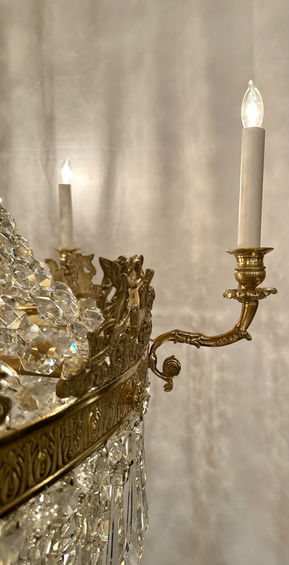SKU:
CHC422
Antique 19th Century French Empire Baccarat Crystal and Ormolu Chandelier
Height: 48 inches Diameter: 42 inches
The Empire style flourished during the reign of Emperor Napoleon Bonaparte from 1805-1814. Napoleon was in love with the sense of his own importance and greatness, and the Empire style reflected this in imposing, lavish pieces made to exacting standards. He was attracted to the ancient Greco-Roman and Egyptian cultures and borrowed heavily from their imagery for decoration. Napoleon wanted the world to recognize the greatness of the French, and he achieved this with the Empire style, considered luxury furniture and wildly popular among the upper classes. The style remained popular throughout the 19th century.
Baccarat French crystal has been known for its exceptional quality and expert design since the glassworks was founded in 1764 by royal permission of King Louis XV about 150 miles from Paris. It is one of the oldest luxury glass companies in France.
Since the beginning, Baccarat crystal has been hand-blown and cut. It is one-third lead based, which allows for the beautiful sparkle and characteristic “ping” sound of fine crystal. In the 19th century, the royal families in Paris and other European capitals were impressed by the extreme intricacies and elegance of design, and commissioned Baccarat pieces for their palaces and state residences. The company was awarded many prizes at international exhibitions held in Europe during this period.
Baccarat pieces are signed, with marks and methods varying over the years. The hundreds of amazing styles and forms of crystal used on fine antique chandeliers, sconces and candelabra make the Baccarat name a standout in the history of French antiques.
Bronze d'oré, also known as ormolu or gilt bronze, was a decorative finish used on luxury furnishings in the 18th and 19th centuries. An application of finely ground high carat gold and mercury amalgam was placed on objects of bronze. When subjected to extremely high heat, the mercury evaporated, leaving behind a lustrous coating of gold.






